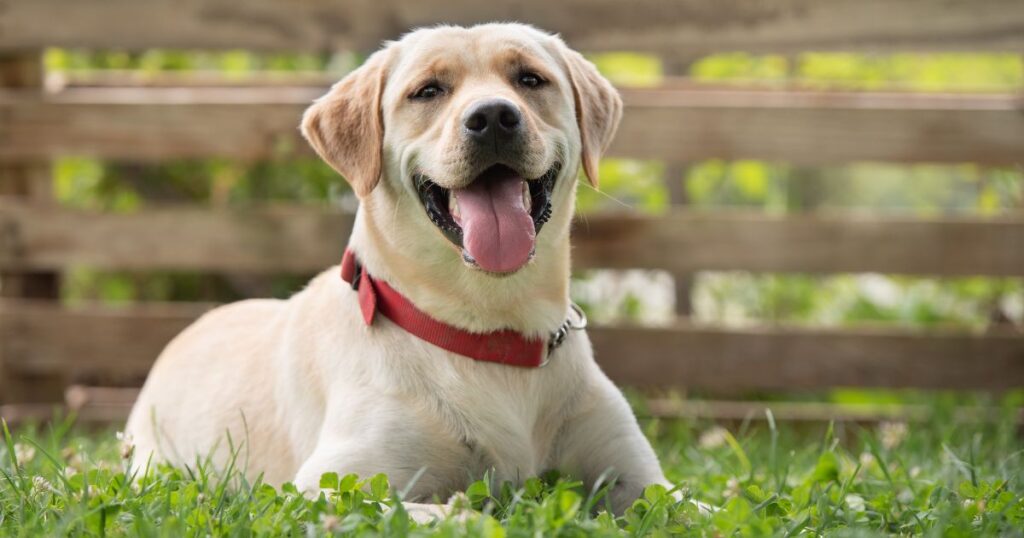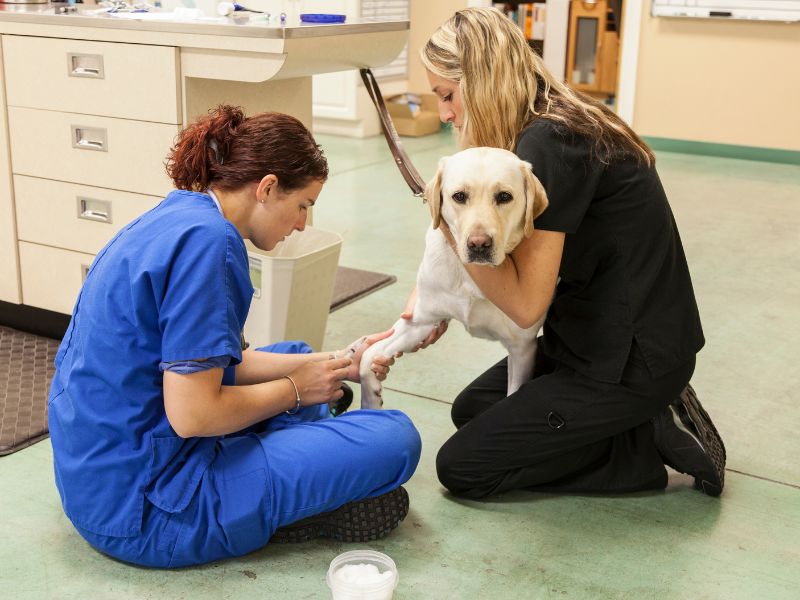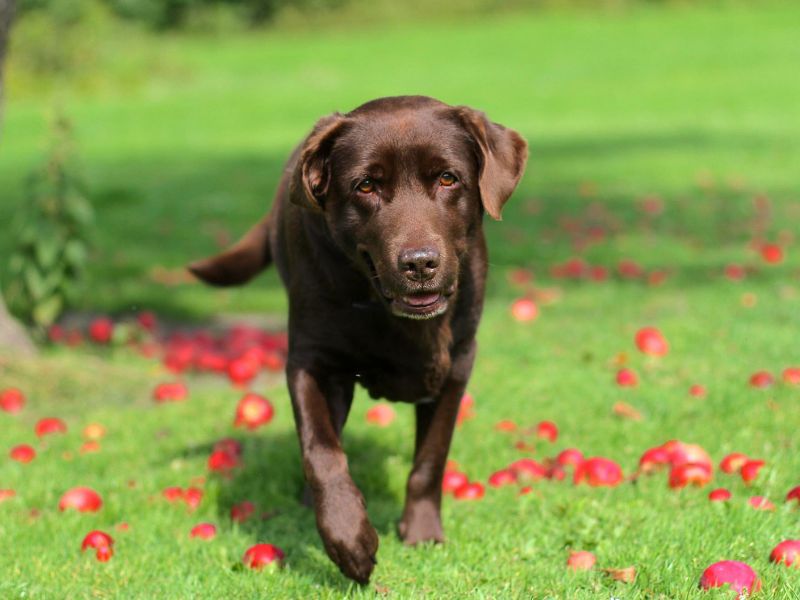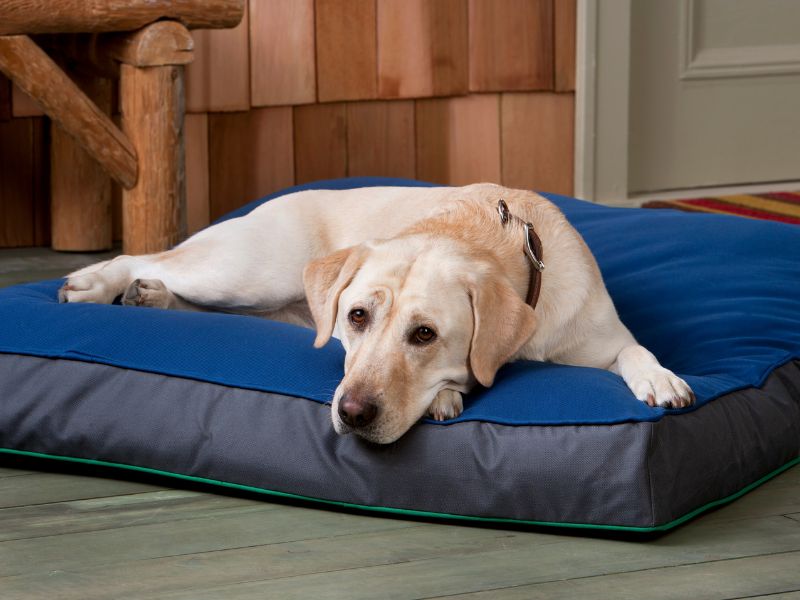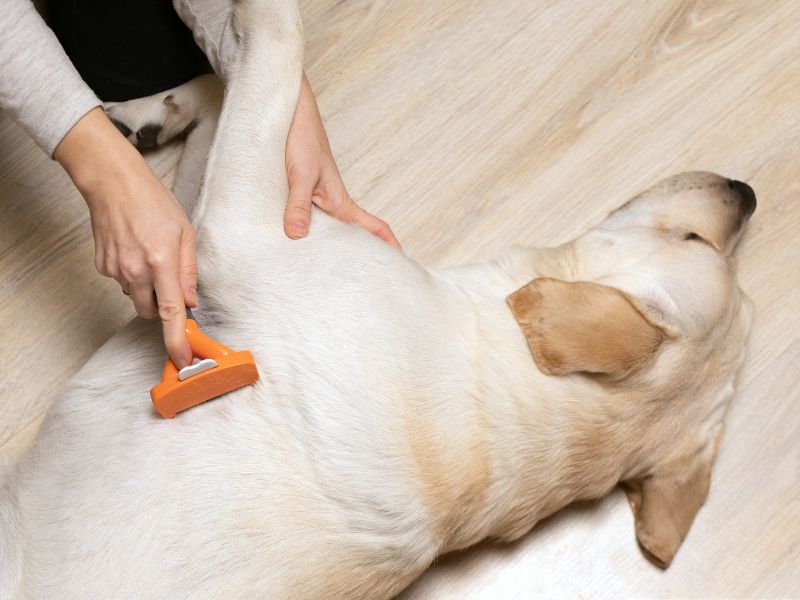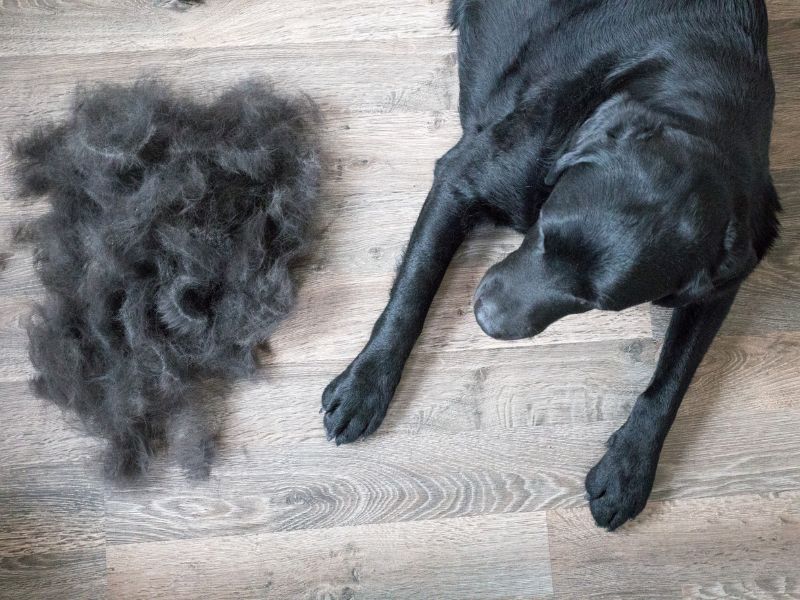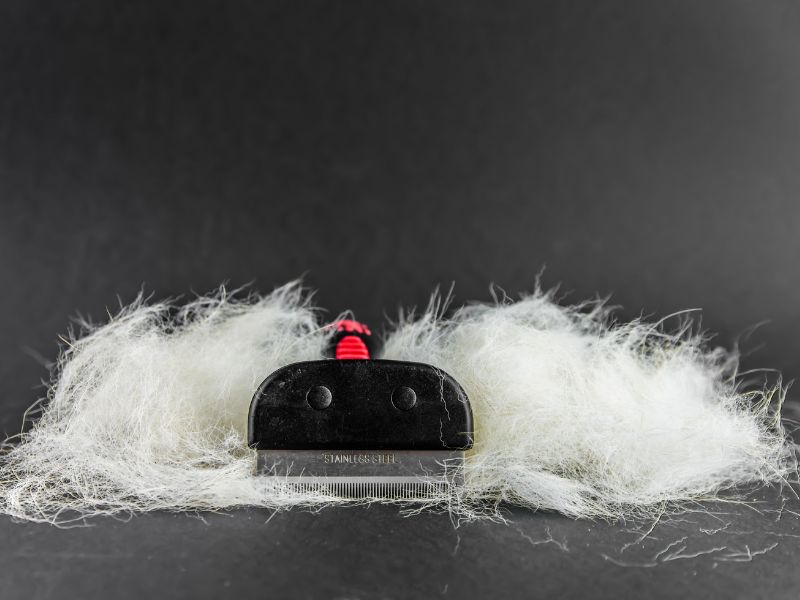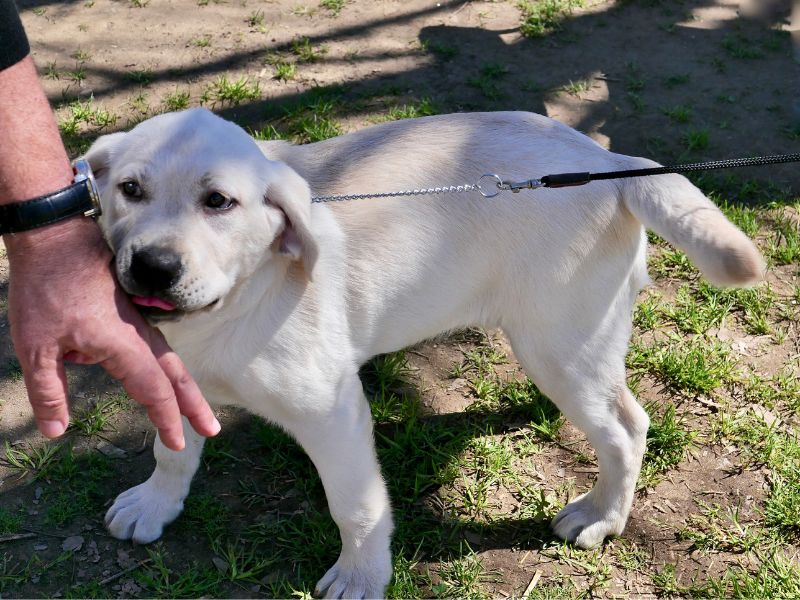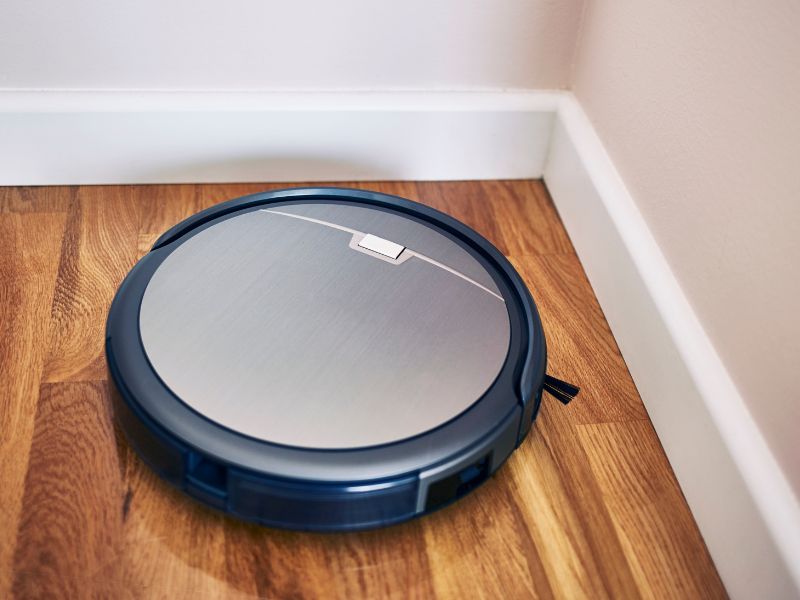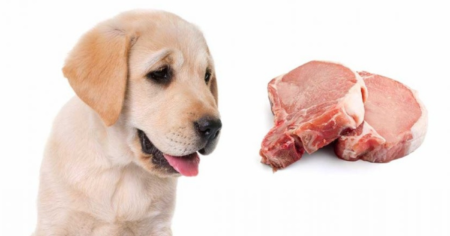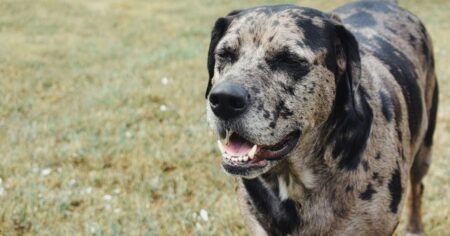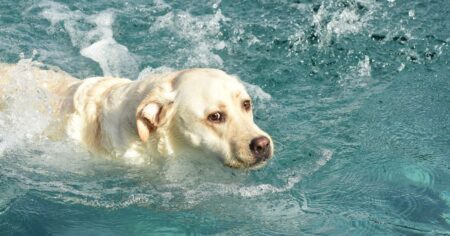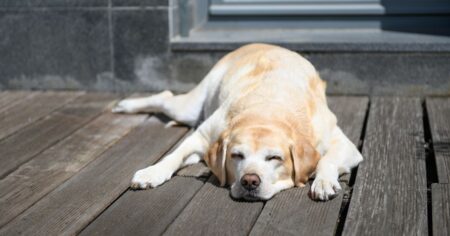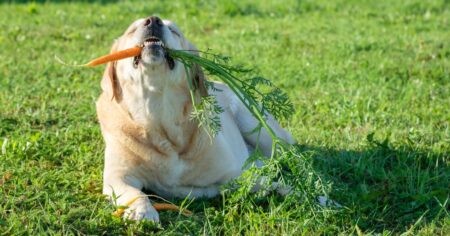Labrador owners often anticipate the arrival of the moulting season, a time when their beloved canine companions begin to shed their fur in large amounts. As the seasons change, Labradors go through a process of shedding their old fur to make way for a fresh coat. While this can be a nuisance for pet owners, understanding the shedding patterns and how to manage them can be highly beneficial.
All Labrador colors go through this normal shedding process, with the most effective way to mitigate loose fur and excessive cleaning being proper grooming. Establishing a solid routine for brushing your Labrador Retriever is crucial, even when they’re not in the molting phase.
Seasonal shedding, or moulting, happens twice a year, and can sometimes be influenced by factors such as female heat cycles or climate. Developing informed strategies for managing Labrador shedding can make a significant difference in the cleanliness of your home and the overall health and happiness of your furry friend.
Why Do Dogs Shed?
Dogs, including Labrador Retrievers, shed their hair as a natural process. Shedding helps maintain a healthy coat and regulates their body temperature. Shedding is more pronounced in double-coated breeds like Labradors, which have both a dense undercoat and a protective topcoat.
One common reason for shedding in dogs is seasonal changes. As temperatures rise in the spring, dogs shed their thick winter coats, replacing them with thinner coats to stay cool during the summer. Similarly, in the fall, they shed their lighter coats to prepare for the colder months ahead by growing a denser winter coat.
Indoor dogs may shed year-round due to the artificial heat and light in their homes, which don’t provide the natural seasonal signals that control when shedding occurs. The surrounding environment plays a vital role in influencing a dog’s shedding patterns.
Health and well-being are additional factors that can contribute to a dog’s shedding. Stress, anxiety, and various health conditions may lead to excessive shedding. For instance, endocrine disorders such as hypothyroidism or congenital problems like follicular dysplasia can result in increased shedding.
In conclusion, shedding is a natural process for dogs, including Labradors, and is influenced by factors such as seasonal changes, indoor environments, and the dog’s overall health. As a dog owner, using the right grooming tools with a consistent routine will help manage and maintain your dog’s coat during these moulting seasons.
Do Labs Shed All The Time?
Labrador Retrievers are known for their friendly nature, intelligence, and adaptability. However, potential owners should be aware that Labs also have a reputation for shedding. Although Labradors shed moderately throughout the year, the amount of shedding significantly increases during the molting or shedding season. This seasonal shedding occurs twice a year and can last anywhere from two to three weeks at a time.
In the spring, Labrador Retrievers shed their winter coats and prepare for the summer months. During this time, they will lose a considerable amount of hair, which helps them stay cool as the temperature rises. Similarly, in the autumn, Labs shed their summer coats to make way for a thicker winter coat that provides insulation during the cold months.
Several factors can influence the shedding patterns of Labradors. For instance, unspayed female Labs tend to shed more when they are in heat. Additionally, dogs living in hotter climates may shed more consistently throughout the year, as they require less hair to stay warm compared to those living in colder regions.
To keep your Labrador’s shedding in check, it’s essential to establish a grooming routine. Regular brushing will help remove loose hair and prevent mats or tangles, making both seasonal shedding and year-round maintenance more manageable. Having the right tools, such as a deshedding brush or a grooming rake, can make a significant difference in controlling their shedding.
In summary, Labrador Retrievers do shed all year, with a noticeable increase in shedding during the molting season. A consistent grooming routine and correct tools are vital in managing the shedding process, ensuring that both you and your Lab remain comfortable throughout the year.
Why Does My Labrador Shed So Much?
Labradors are known for being great companions, but they’re also notorious for shedding a lot of hair. This is a natural occurrence and is particularly noticeable during the moulting season when the seasons change. Shedding helps Labradors maintain their beautiful coats by getting rid of old, damaged, or loose hairs.
One factor that contributes to excessive shedding in Labradors is their active lifestyle. These energetic dogs are likely to spend a lot of time running and playing outside, which can cause extra wear and tear on their coats. This physical activity promotes the natural loss of hair, which would then be replaced by new, healthy growth.
Additionally, Labrador Retrievers have a double coat, consisting of a soft, dense undercoat and a straight, protective topcoat. This double coat helps them regulate their body temperature in various weather conditions, but it also means that they will shed more as they lose both layers of fur throughout the year.
Another reason your Labrador might be shedding more than usual is due to allergies or skin issues. If your pup has any dryness or irritation on their skin, it can lead to excessive shedding. In such cases, it’s essential to consult with a veterinarian to address the underlying issues and minimize excessive hair loss.
In conclusion, while Labrador shedding is a natural and essential process for maintaining a healthy coat, it’s important to keep up a good grooming routine and address any allergies or skin issues that may be contributing to excessive shedding. This way, you can help manage your Labrador’s shedding and keep their beautiful coat in top condition.
Special Double Coat
Labrador Retrievers are known for their special double coat. This feature is not only an essential part of their distinctive appearance but also serves important functions for their health and well-being.
The double coat consists of two main parts: the undercoat and the overcoat. The undercoat is primarily responsible for temperature regulation, helping your Labrador stay warm when diving into icy cold waters. This dense and insulating layer traps air close to the skin, which aids in keeping the body warm.
On the other hand, the overcoat consists of longer guard hairs that protect the undercoat and skin from harsh weather conditions. It also helps repel water, keeping your Labrador dry and comfortable after a swim or play in the rain. This combination of layers gives Labradors the ability to thrive in different weather situations.
Shedding is a natural process in which Labradors lose old and damaged hairs to make room for new, healthy ones. It is most commonly observed during the transition from winter to summer when dogs shed their thicker winter coats to stay cool in the warmer months. During this time, it’s normal to find more hair around your home and on your clothes.
Grooming your Labrador regularly can help keep shedding under control. Using the right tools, such as the FURminator brush specially designed for short-hair breeds, ensures that you effectively remove dead hair and promote healthy oil distribution for a shiny, well-maintained coat.
In conclusion, the special double coat of Labradors serves many purposes, from insulation and protection to adapting to seasonal changes. Shedding is a natural and expected part of this process, and proper grooming can help maintain the health and appearance of your dog’s coat.
Do Yellow Labradors Shed More Than Black Labradors?
It’s a common question among Labrador owners and enthusiasts: Do yellow Labradors shed more than their black counterparts? The truth is, there is no significant difference in shedding between the different colors of Labradors. All Labradors have a double coat that consists of a soft, dense undercoat and a protective topcoat, allowing them to stay warm and dry in various conditions.
While it’s true that yellow Labs might seem to shed more, this is likely due to their lighter hair being more visible on dark surfaces, upholstery, and clothing. It’s important to note that shedding is a natural process for Labradors, and they tend to shed moderately throughout the year. However, during molting or shedding seasons, which occur twice a year, the shedding can be more noticeable.
During these molting seasons, Labs shed their coats in preparation for the change in weather. In spring, they shed their winter coat, and in autumn, they transition from their summer to winter coat. This process usually lasts for two to three weeks, and it’s during this time that Labrador owners might notice an increase in shedding.
To manage a shedding Labrador, regardless of color, it’s essential to establish a grooming routine for your furry friend. Regular brushing with a deshedding tool or slicker brush can help remove loose hair, reduce shedding, and keep your home (and clothes) cleaner. Additionally, providing a balanced diet for your Labrador and ensuring they have adequate exercise can contribute to maintaining a healthy coat.
In summary, while it might seem that yellow Labradors shed more than black Labradors, the shedding frequency and amount are more or less the same between the two colors. By implementing a proper grooming routine and understanding the natural shedding process, you can keep your Labrador looking great, and your home cleaner, regardless of coat color.
Home Comforts And Hairy Problems
As a Labrador owner, one of the challenges you are likely to face is shedding, especially during the moulting seasons. Shedding is a natural process for Labradors, as they shed their thick winter coats in spring and their lighter summer coats in the fall to maintain proper body temperature.
To maintain a clean and comfortable home environment, it’s essential to have an effective grooming routine in place. Regular brushing can help reduce the amount of loose hair that ends up around your house. Make sure to use a suitable brush or comb designed for Labradors’ double-layered coats.
Vacuuming your home frequently is another crucial step in controlling Labrador hair. There are many vacuum cleaners in the market specifically designed for dealing with pet fur. Regular vacuuming, particularly during shedding seasons, helps keep your home tidy and minimizes hair accumulation on floors and furniture.
Reducing your Lab’s stress levels can also contribute to minimizing shedding. A healthy diet, sufficient exercise, and creating a calm environment can go a long way in keeping your furry friend relaxed and content.
In summary, while you can’t stop a Labrador from shedding, you can certainly manage the hairy problems it presents with an effective grooming routine, proper cleaning techniques, and a stress-free environment. By adopting these practices, you’ll ensure both your home and your Labrador stay comfortable during the moulting season.
How To Cope With Labrador Shedding
Labrador Retrievers are known for their shedding, which can be a challenge for pet owners. Fortunately, there are ways to manage and reduce shedding in these lovable dogs.
Firstly, establish a regular grooming routine to keep your Labrador’s coat healthy and remove loose hairs. Brushing your Lab weekly with a slicker or pin brush is a good starting point. During the moulting seasons, when shedding is more intense, use a deshedding tool for thorough grooming sessions.
Another useful tip is giving your Labrador frequent baths. Bathing your dog every month or as needed can help eliminate dirt and debris from their coat, reducing excess shedding. Use a gentle dog-specific shampoo to ensure that your Lab’s skin is not irritated by harsh chemicals.
Maintaining a balanced and nutritious diet is also essential for your Labrador’s overall coat health. A high-quality dog food with essential fatty acids like omega-3 and omega-6 can promote a healthier coat and skin. You can also incorporate supplements or treats with fatty acids to give your Lab an extra boost.
It’s standard for Labradors to shed more in the spring and fall as they transition between their thicker winter coat and thinner summer coat. Therefore, it’s essential to prepare as these seasons approach, and adjust your grooming routine accordingly.
Finally, to keep your home fur-free, invest in a robust vacuum cleaner designed for pet hair. Frequent vacuuming can significantly reduce the amount of dog hair around your home. You can also use furniture covers and washable rugs to minimize fur buildup on your belongings.
In summary, coping with Labrador shedding involves a combination of regular grooming, bathing, proper nutrition, vacuuming, and seasonal adjustments to your dog’s care routine. With these tips in place, both you and your furry friend can enjoy a more comfortable and fur-free environment.
Removing Hair From Your Labrador
Labrador shedding is a reality that all lab owners face, especially during the molting season. Here are some friendly tips to help you manage your furry friend’s shedding and keep both your pet and your home looking their best.
Firstly, establish a regular grooming routine with your Labrador. Brushing your dog once a week with a slicker or pin brush can help remove loose hair and prevent it from accumulating in your home. During molting season, consider using a deshedding tool for a more thorough grooming.
In addition to grooming, bathing your Labrador occasionally can help reduce shedding. Use a mild dog shampoo and make sure to thoroughly rinse it from your dog’s coat. Be cautious not to bathe your dog too frequently, as this can strip away their coat’s natural oils and lead to skin problems.
Maintaining a healthy diet is also essential for controlling shedding in Labradors. Providing your dog with high-quality, nutritious food can contribute to a healthier coat, resulting in less shedding. Supplementing their diet with Omega-3 fatty acids, such as fish oil, can also promote a glossy and healthy coat.
To keep your home as fur-free as possible, invest in a good vacuum cleaner designed specifically for pet hair. Regularly vacuum your home, paying special attention to areas where your Labrador spends the most time. Using lint rollers, pet hair removal tools, or even rubber gloves can be effective in removing pet hair from furniture and clothing.
By implementing these friendly tips, you can successfully manage your Labrador’s shedding during the molting season while maintaining a clean home and a well-groomed pet.
Get Pippa’s Training Tips!
Pippa Mattinson, a renowned dog expert, has some valuable advice for Labrador owners who are dealing with their Labradors shedding, especially during the moulting season. By following Pippa’s training tips, you can help minimize the shedding challenges while maintaining a strong bond with your Labrador.
Establish a Regular Grooming Routine
One of Pippa’s suggestions is to establish a weekly grooming routine that includes brushing your Labrador’s coat. This will ensure that loose hair is removed, which will reduce shedding around your home. Using a slicker or pin brush could make this task more manageable and enjoyable for both you and your fur friend.
Choose the Right Tools
Make sure to equip yourself with the right grooming tools. A slicker brush, pin brush, or de-shedding tool can be beneficial when battling shedding season. These tools are specifically designed to remove loose hair from your Labrador’s coat, helping to reduce the amount of hair that ends up on your floors and furniture.
Pay Attention to Your Lab’s Dietary Needs
Your Labrador’s diet also plays a crucial role in its overall health and shedding habits. By providing high-quality dog food rich in essential nutrients, like omega-3 fatty acids, you can help improve your dog’s coat condition and reduce shedding issues. Ensure that you consult your veterinarian to select the most appropriate food for your Labrador.
Monitor Your Labrador’s Health
Lastly, Pippa emphasizes the importance of keeping an eye on your Labrador’s overall health. If you notice any sudden changes in their shedding patterns, it could be a sign of an underlying health issue. Don’t hesitate to consult your veterinarian if you have concerns about your Labrador’s health or shedding habits.
By implementing Pippa Mattinson’s training tips, Labrador owners can navigate the challenges of the moulting season more efficiently and keep their homes cleaner. Moreover, these practices will help maintain a strong and healthy bond with their beloved Labradors.
The Zoom Groom
The Zoom Groom is a popular and effective tool for managing your Labrador’s shedding during the moulting season. This brush is specifically designed to remove dead hair from your dog’s coat without being too harsh on their skin.
One benefit of using the Zoom Groom is that it is gentle enough for regular use, ensuring that the shedding process can be managed consistently. This helps to maintain a clean and healthy coat for your Labrador, and ultimately, reduces the amount of fur that ends up around your home.
Another advantage of utilizing the Zoom Groom for your Lab’s moulting is its ability to provide a gentle massage as you work through their coat. This can be both soothing and enjoyable for your dog, promoting a positive grooming experience as well as a stronger bond with your pet.
Incorporating the Zoom Groom into your regular grooming routine can make a significant difference during the moulting seasons – typically spring and autumn. By using this effective tool, you can help keep your Labrador’s coat looking its best while also minimizing excess hair in your living space.
Remember, maintaining a consistent grooming regimen with tools like the Zoom Groom can greatly impact your dog’s overall health and happiness. So take a moment to ensure your Labrador looks and feels their best, especially during those pesky moulting seasons.
The Furminator
Labrador owners are no strangers to shedding, especially during the moulting seasons. A popular tool to help manage Labrador shedding is the Furminator. This deshedding tool effectively removes loose hair and undercoat, making it a valuable addition to your grooming routine. Its stainless-steel edge easily glides through the dog’s topcoat without damaging it, while the ergonomic handle ensures comfort and ease of use.
The Furminator can be particularly helpful during the moulting seasons, which typically occur in spring and fall. This is when Labradors transition between their thick winter coat and thinner summer coat, and vice versa. Regular use of the Furminator during these times can help reduce the amount of fur that finds its way onto your furniture, floors, and clothing.
When using the Furminator, it’s essential to be gentle and cautious. Too much pressure or excessive use can potentially harm your Labrador’s skin or damage its coat. It’s recommended to groom your dog in the direction of the hair growth and to avoid sensitive areas, such as the face and genitals.
In addition to using the Furminator, maintaining a consistent grooming routine with regular brushing can help keep your Labrador’s coat healthy and reduce shedding. Brushing helps distribute natural oils throughout the coat, which can improve its overall condition and appearance. To further minimize shedding, ensure your Labrador has a well-balanced diet and receives regular veterinary care, as poor nutrition and health issues can contribute to excessive shedding.
With proper use and care, the Furminator can be an effective tool in managing your Labrador’s shedding, especially during the moulting seasons. By combining the Furminator with other grooming practices and proper pet care, you can keep your Labrador looking and feeling its best all year round.
Use Your Furminator Carefully
Labrador shedding can be quite the ordeal, especially during the moulting season. One popular tool to manage the shedding is a Furminator. However, it’s essential to use this tool carefully to avoid harming your Labrador’s sensitive skin and coat.
The Furminator is an excellent tool for removing loose fur and reducing the amount of shedding, but it requires proper technique and caution. To effectively use a Furminator, follow these friendly tips:
- Start with a clean and dry coat: Make sure your Labrador’s fur is clean and dry before using the Furminator. This helps prevent any tangles or mats that could cause discomfort during the grooming process.
- Gentle strokes: Use gentle, even strokes when using the Furminator on your Labrador’s coat. Apply minimal pressure, letting the device’s comb teeth do the work. Avoid pulling or tugging on their fur, as this could be painful and lead to skin irritation.
- Focus on one area at a time: Work on one area of your Labrador’s coat before moving on to another. This ensures a systematic approach to grooming and prevents over-brushing any particular area.
- Monitor your Labrador’s comfort: Keep an eye on your Labrador’s body language and reactions while using the Furminator. If they show signs of discomfort or pain, such as flinching or whining, stop immediately and reassess your technique.
- Don’t overdo it: Using the Furminator too often or for extended periods can cause skin irritation or even damage your Labrador’s coat. Follow the manufacturer’s recommendations for frequency of use and keep grooming sessions brief.
Remember, the key to successfully using a Furminator is a gentle touch and consistency. By showing care and consideration for your Labrador’s comfort during the shedding season, you’ll help maintain their beautiful coat while easing the impact of shedding in your home.
Can I Shave My Labrador?
Shaving a Labrador Retriever might seem like a solution to excessive shedding during the moulting season, but it is not recommended. Labradors have a double coat – a dense undercoat and a water-repellent outer coat – that provides insulation, temperature regulation, and protection against the elements. Shaving your Labrador can strip them of these vital capabilities, and might do more harm than good.
Even though Labradors shed extensively in the spring and fall when their coats transition between thick and thin, there are more appropriate ways to manage shedding without resorting to shaving. Grooming tools such as deshedding brushes can efficiently remove loose hair from your Labrador’s coat, making it more manageable and reducing shedding around your home. Establishing a consistent grooming routine, especially during the moulting season, is essential to keeping your Labrador’s coat healthy and reducing shedding.
It’s important to note that the double coat of a Labrador Retriever serves a crucial purpose, and shaving it can have unintended consequences. A shaved Labrador loses its ability to regulate body temperature, making them susceptible to heatstroke in the summer and hypothermia in the winter. Moreover, the coat also protects their skin from sunburn and insect bites. Not to mention, shaving a Labrador can disrupt the natural shedding cycle, resulting in an uneven regrowth of their fur.
In conclusion, it’s best to resist the urge to shave your Labrador during the moulting season. Instead, invest in the proper grooming tools and take the time to groom them regularly. This way, your furry friend can maintain a healthy coat while staying protected from the elements all year round.
Removing Dog Hair From Your Home
Labradors are known to shed, especially during moulting season, and it can be a challenge for pet owners to keep their homes clean and free from pet hair. In this section, we will discuss a few effective strategies to remove dog hair from your home, making the task less daunting and more manageable.
Do Robot Vacuum Cleaners Pick Up Dog Hair?
One popular question among Labrador owners is the effectiveness of robot vacuum cleaners in picking up dog hair. The good news is that many modern robot vacuum cleaners are designed specifically to handle pet hair. They come with powerful suction, specialized brushes, and filters to trap and collect even the finest of pet hairs.
When choosing a robot vacuum cleaner for tackling Labrador shedding, consider the following features:
- Strong suction power: Opt for a model with adjustable suction settings, ensuring it can handle varying floor types and levels of pet hair.
- Brushes designed for pet hair: Some robot vacuums are equipped with specialized brushes that can easily pick up pet hair without getting tangled.
- High-performance filters: Look for a vacuum with high-efficiency filters, which can effectively trap pet allergens, as well as hair, preventing them from being released back into your home.
In summary, robot vacuum cleaners can be a valuable tool in managing pet hair in your home, especially if you choose a model that is designed to deal with dog hair specifically. These devices can save you time and effort, allowing you to focus on enjoying your Labrador’s companionship while maintaining a clean and comfortable living space.

